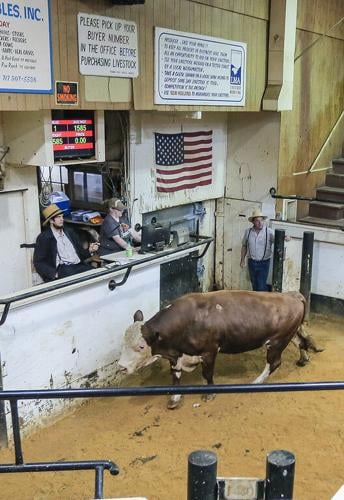Things are a bit heavier in Mike Holland's butcher shop lately.
The co-owner of Holland Brothers Meats in Duncansville, Pennsylvania, said the weight of a finished steer has increased a bit, and he's not sure why.
"It sure seems that way. I like to have them 600 to 650 pounds on the rail, and they're all coming in at 700 to 750," Holland said. "I've noticed it trending that way for about the last three months."
Bill Weist, owner of Middleburg Livestock Auction, confirmed the trend at his weekly sale.
"The fat steers are averaging 1,400 pounds. It's slowly been getting heavier," he said.
There are some possible explanations for the higher finishing weights.
According to Dave Wert, president of Ag Market News, producers may want to pack a few extra pounds on their animals to get more return and help cover increased input costs, such as feed. Some beef farmers may have ample supplies of feed, he added, so they can afford to keep an animal a bit longer. On the other hand, not every farmer has access to a scale, so perhaps they're simply misjudging the weights of their animals when sending them to auction.
"Probably the 1,400 to 1,500-pound range is the premium weight at the auctions now," Wert said. "When you get above 1,600 pounds, the carcass is getting too big for the rail in some cases. At the 1,100 to 1,200-pound range, you might not have the finish on the animal."
While more weight may equate to more money at the auction or from direct sales of freezer beef, Holland said heavier isn’t always better. Selling a half or whole steer with a live weight of 1,500 pounds or more — assuming 60% of that will be the hanging weight — may be too costly for some consumers.
“You have to think of your customer. An extra 100 pounds hits the pocket book and adds more cover to the carcass, which means more waste that’s being charged for, but not necessarily more steaks,” he said.
Holland says a good target weight for a steer intended for custom butchering is 1,300 pounds, but that’s not a universal goal.
Beef farmer Parker Bell, who owns BB Land and Cattle Company in Tyrone, Pennsylvania, said lighter finished steers are better for direct to consumer sales because people don’t want to pay for excessive fat. When selling to packers, a heavier animal may be fine because premiums are possible with a steer that grades as Choice.
But there is one factor that Bell bases his determination of what constitutes an appropriate finished weight.
“Finish weight for me depends on the frame of the animal. You might have an animal that grades Choice at 1,400 pounds, and another animal with a large frame can add the extra pounds and finish at a heavier weight,” he said.
When Wert grades finished steers at an auction, he looks for several physical attributes to determine if an animal is High Choice or Prime.
The first area he checks is the brisket. If it’s filled out, the animal is Prime, or if the brisket is thin and floppy, it could be graded Select.
Other factors indicating a Prime grade include the presence of a bubble of fat behind the hind leg, a grapefruit-sized lump of fat on each side of the tailhead, and a flat back.
Muscling and back fat are important in grading,” Wert said.
One factor that could influence the trend of heavier finishing weight is the price of feed. As grain prices continue to climb and feed costs increase as a result, Wert said it could compel some producers to move their animals to sales at lower finishing weights.
“They might want to get those animals out early to limit grain,” he said. “It won’t be everybody and you’ll still have people stay with the 1,400 to 1,500 finish weights if they have enough feed to do it.”
Still, a finished animal on the lighter side can still have demand in the marketplace.
Wert said there’s strong demand among certain ethnic groups for lean animals weighing 1,100 to 1,200 pounds. And Bell added that some customers simply want a lighter animal not only because it costs less, but they prefer leaner meat and less fat.
“There seems to be a demand for everything right now,” Wert said. “It always changes. Some weeks the heavier animals will bring top prices, and some weeks at the auction the trend is buyers looking for the leaner steers.”


